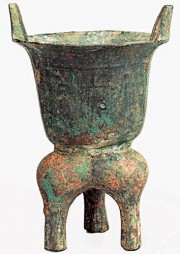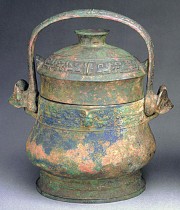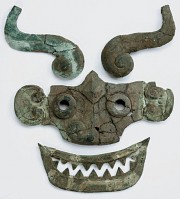This area demonstrates tomb M60 and horse-and-chariot pit M3 excavated at Hsin-ts’un, Chun-hsien, Honan. M60 is among the few tombs undisturbed by looters at this Western Chou cemetery. Inside the tomb, the burial space measures 2.85m in its length and 1.6m in its width, with only a single coffin. Though not many accompanying burial artifacts are presented, the sources of these artifacts are rather complicated. Among these artifacts, there are relatively larger numbers of weapons and horse-and-chariot fittings; consequently, the occupant of this tomb is thought to be a middle-ranking aristocracy.
Pit M3 is the largest horse-and-chariot pit at the cemetery, which measures 10 m east-west by 9.1 m north-south. Many accompanying horse burials and exquisite chariot fittings are found inside the pit. This pit supposedly dates to the Middle and Late Western Chou periods (tenth-ninth century B.C.)

|
Yen Steamer with the Character
Resource Identifier:R020014
Description:This piece is composed of a tseng cooking vessel and a li cauldron cast together. There was probably a grill in between, which is now missing. Two rounds of vague bowstring lines appear on the surface. A small vertical line and two dots between the two rounds of bowstring lines roughly represent the nose and the eyes of an animal mask. Inside the steamer is an inscription “ *”。
Date:Mid 11th century-771 B.C.
Format:Height 30.2, diameter of mouth 17.0 cm.
Coverage:Tomb M60, Hsin-ts’un, Chun-hsien, Honan |
| |
|
| |
|

|
Chueh Cup Inscribed with the Characters “父癸Fu Kuei”
Resource Identifier:R020001
Description:A pair of capped posts appears on the rim with whorl patterns on the caps. One band of animal-masks decorates the body. Ox-head decoration is seen on the handle which is inscribed with the characters “父癸Fu Kuei.”
Date:Mid 11th century-771 B.C.
Format:Height 21.3, length 17.8
Coverage:Tomb M60, Hsin-ts’un, Chun-hsien, Honan |
| |
|
| |
|

|
Yu Flask
Resource Identifier:R020012
Description:The vessel has an oval cross-section, with k’uei dragons decorating the lid, body and swing handle. Similar inscriptions are found inside the lid and the vessel, each with six characters, indicating it belonged to the person named “邊 Pien.”
Date:Mid 11th century-771 B.C.
Format:Height 282.2, width of belly 19.5 cm
Coverage:Tomb M60, Hsin-ts’un, Chun-hsien, Honan |
| |
|
| |
|

|
Chariot Wheel Ornaments: Nave-sheathing (outer end) Nave-sheathing (inner end)
Resource Identifier:R019048_01,R019050_01
Description:The nave is the thickest portion of the chariot wheel axle, used to link the axle to the spokes. In order to protect the chariot axle and also to beautify the chariot, the nave of Western Chou chariots was often wrapped in bronze.
The four groups of long nave-sheathing from this tomb are the longest, most ornate Western Chou nave-sheathings discovered thus far. The tripartite bronze nave-sheathing was cast as a whole piece decorated with coiled ch’ih dragons and “人” shaped patterns.
Date:Mid 11th century-771 B.C.
Format:Length 20.9, diameter of two ends 18.8, 11.5 cm;
Length 32.0 diameter of two ends 17.9, 9.0 cm
Coverage:Horse and Chariot Pit M3, Hsin-hsien, Honan, Chun-hsien Honan |
| |
|
| |
|

|
Chest Plate Ornaments in the Shape of an Animal Face
Resource Identifier:R019970
Description:In the cemetery of Hsin-ts’un, from tombs M2, M8, M19 and other larger or medium sized tombs, the largest in number and variety of artifacts from the Western Chou period are excavated. It is easy to distinguish two horns, a face and a mouth of a beast on the chest-plate. Because war armor was often placed beside horse implements, these ornaments were often mistaken for horse frontlets. But because of the holes drilled on the rare side, it is possible to tell that this chest plate was originally stitched on leather armor.
Date:Mid 11th century-771 B.C.
Format:Length 25.5, width 23.0 cm
Coverage:Tomb M2, Hsin-ts’un, Chun-hsien, Honan |
| |
|
| |
|

|
Tsun Vessel
Resource Identifier:R020015
Description:pair of ox heads and a band of k'uei dragons appear on the upper section of the vessel belly, and a band of k'uei dragons decorates the lower section. Both sections have angular spirals as background. There are a total of twenty-four inscribed characters on the vessel, noting that Lu was granted some cowries by the duke for having followed him, and that Lu used the cowries to make this precious vessel as a sacrificial offering to Fu I.
Date:Mid 11th century-771 B.C.
Format:Height22.9,diameter of mouth 19.7 cm
Coverage:Tomb M60, Hsin-ts’un, Chun-hsien, Honan |
Text and images are provided by Institute of History and Philology, Academia Sinica
Digital Resources and Archived Images Application
|


















